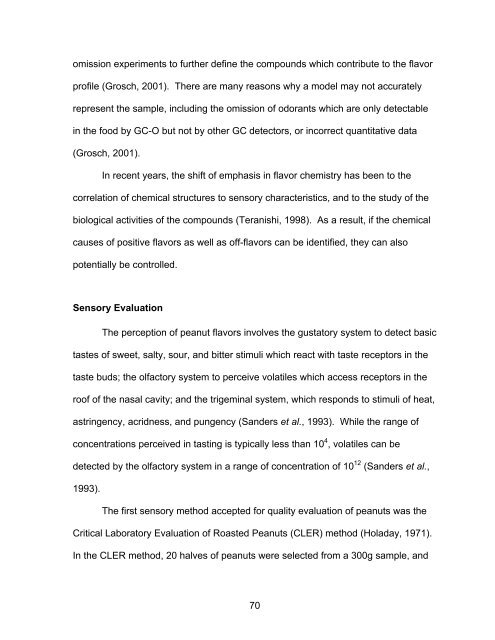Abstract SCHIRACK, ANDRIANA VAIS. The Effect of Microwave ...
Abstract SCHIRACK, ANDRIANA VAIS. The Effect of Microwave ...
Abstract SCHIRACK, ANDRIANA VAIS. The Effect of Microwave ...
You also want an ePaper? Increase the reach of your titles
YUMPU automatically turns print PDFs into web optimized ePapers that Google loves.
omission experiments to further define the compounds which contribute to the flavor<br />
pr<strong>of</strong>ile (Grosch, 2001). <strong>The</strong>re are many reasons why a model may not accurately<br />
represent the sample, including the omission <strong>of</strong> odorants which are only detectable<br />
in the food by GC-O but not by other GC detectors, or incorrect quantitative data<br />
(Grosch, 2001).<br />
In recent years, the shift <strong>of</strong> emphasis in flavor chemistry has been to the<br />
correlation <strong>of</strong> chemical structures to sensory characteristics, and to the study <strong>of</strong> the<br />
biological activities <strong>of</strong> the compounds (Teranishi, 1998). As a result, if the chemical<br />
causes <strong>of</strong> positive flavors as well as <strong>of</strong>f-flavors can be identified, they can also<br />
potentially be controlled.<br />
Sensory Evaluation<br />
<strong>The</strong> perception <strong>of</strong> peanut flavors involves the gustatory system to detect basic<br />
tastes <strong>of</strong> sweet, salty, sour, and bitter stimuli which react with taste receptors in the<br />
taste buds; the olfactory system to perceive volatiles which access receptors in the<br />
ro<strong>of</strong> <strong>of</strong> the nasal cavity; and the trigeminal system, which responds to stimuli <strong>of</strong> heat,<br />
astringency, acridness, and pungency (Sanders et al., 1993). While the range <strong>of</strong><br />
concentrations perceived in tasting is typically less than 10 4 , volatiles can be<br />
detected by the olfactory system in a range <strong>of</strong> concentration <strong>of</strong> 10 12 (Sanders et al.,<br />
1993).<br />
<strong>The</strong> first sensory method accepted for quality evaluation <strong>of</strong> peanuts was the<br />
Critical Laboratory Evaluation <strong>of</strong> Roasted Peanuts (CLER) method (Holaday, 1971).<br />
In the CLER method, 20 halves <strong>of</strong> peanuts were selected from a 300g sample, and<br />
70

















